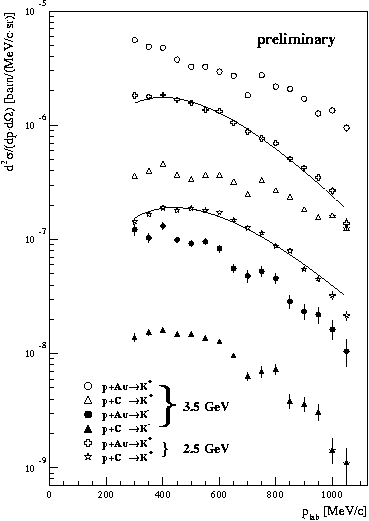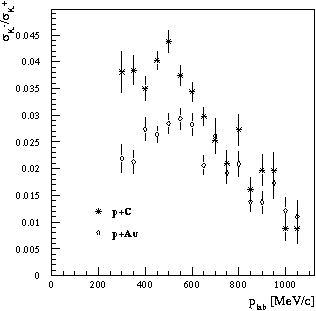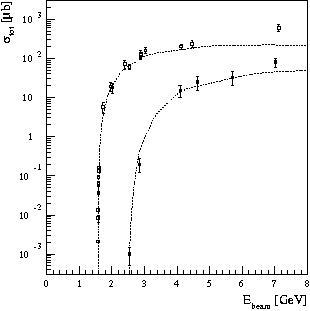|
During the last year the analysis of the data on K+ and K- production in
proton-nucleus collisions has continued and now first results can be presented.
The experiment already described in the last annual report had taken place 1998
at SIS/GSI Darmstadt. In the kaon spectrometer a new 2nd level
trigger enabled beam intensities above 109 s-1 to be applied.

Fig. 1 Inclusive double differential K-meson
production cross sections versus momentum in the laboratory frame at a polar
angle of 40 °. Only statistical errors are plotted. Open symbols
denote K+, full symbols K-.
Fig. 1 shows double differential cross sections for K± production.
The 3.5 GeV data exhibit structures which might be caused by a yet unknown
problem with the trigger efficiency (the trigger was different for the
2.5 GeV data).
In the 2.5 GeV K+ spectra the maximum of the differential cross
section shifts to lower momenta with increasing mass number. Taking into
account the observation angle of 40°, this is an evidence for the
emission system being different in these targets. The K+ are emitted more
towards target rapidity in the p+Au system. Consequently they are either
produced in secondary reactions or rescattered before leaving the nucleus.
Heavy ion data at comparable energies can well be described by Boltzmann
distributions (e. g. in [1]). When trying this for the proton data, one has to
know the kaon emission frame. Fig. 1 contains the fits of the 2.5 GeV
spectra with a Boltzmann function in the proton-nucleus center-of-mass frame.
An attempt to adjust this distribution in the nucleon-nucleon frame failed.
This can be regarded as a hint for the K+ being produced in multi-step
processes.
The inverse slope parameters are T = 123.5(9) MeV (Au) and
T = 115.5(8) MeV (C).
K+ are scarcely absorbed in nuclear matter because strangeness exchange
reactions are not possible. Antikaons do these reactions, e. g.
K-+N®p+L, so they are strongly absorbed.
In Fig. 2 two K-/K+ ratios at
3.5 GeV are plotted. The difference between carbon and gold target might be a hint
for K- absorption, but can also arise from a difference in the emission
systems between K+ and K-.

|
|

|
|
Fig. 2 K-/K+
ratio at 3.5 GeV, from the spectra of Fig. 1.
|
|
Fig. 3 Compilation [2] of
total cross sections on K+ (left curve) and K- (right curve) production in p+p collisions.
The curves represent parametrizations [4].
|
Over the shown momentum range this ratio is in the same order of magnitude as
the ratio of total p+p cross sections, as can be seen in Fig. 3. So, the
3.5 GeV data seem not to exhibit obvious in-medium effects besides
rescattering and absorption.
If there are such effects, they must be visible more clearly in near-threshold
data, i. e. 1.6 and 2.5 GeV. The future analysis will show this and will
allow a comparison to complementary data from ITEP[3] and COSY/ANKE.
|
1
|
FZR
|
|
6
|
Jagiellonian University Cracow, Institute of Physics, Poland
|
|
2
|
GSI Darmstadt
|
|
7
|
FZR and TU Dresden, Institut für Kern- und Teilchenphysik
|
|
3
|
TU Darmstadt, Institut für Kernphysik
|
|
*
|
FZR, now at Argonne National Laboratory, Argonne IL, USA
|
|
4
|
Universität Marburg, Physikalisches Institut
|
|
**
|
GSI, now at Ohio State University, Columbus OH, USA
|
|
5
|
Universität Frankfurt, Institut für Kernphysik
|
|
|
|
References
|
[1]
|
C. Sturm et al., Phys. Rev. Lett. 86/1 (2001) 39
|
|
[2]
|
P. Senger, H. Ströbele, J. Phys. G 25 (1999) R59
|
|
[3]
|
Y. T. Kiselev et al., J. Phys. G 25 (1999) 381
|
|
[4]
|
A. Sibirtsev, Phys. Lett. B 359 (1995) 29,
|
|
|
A. Sibirtsev et al., Z. Phys. A 358 (1997)
|
IKH
05/29/01
© scheinas
|


